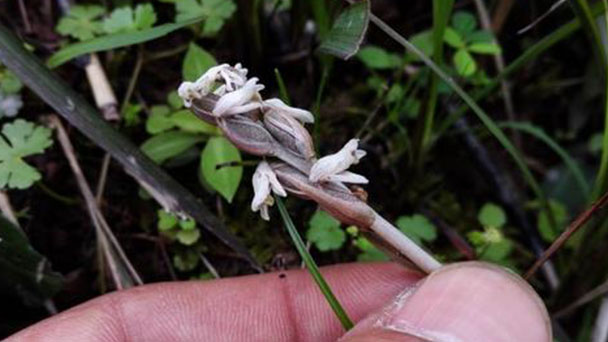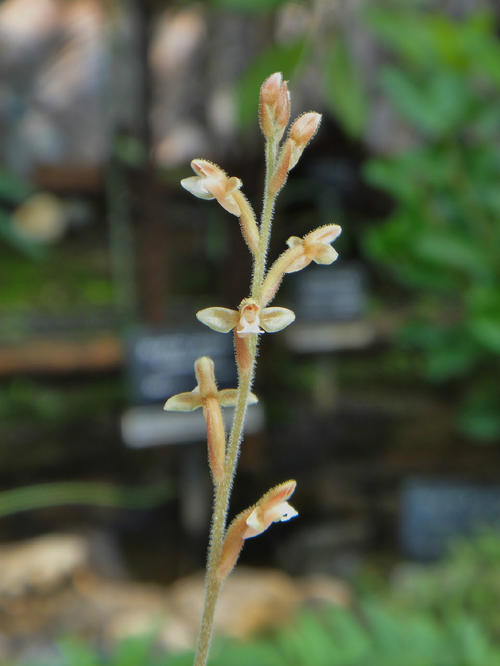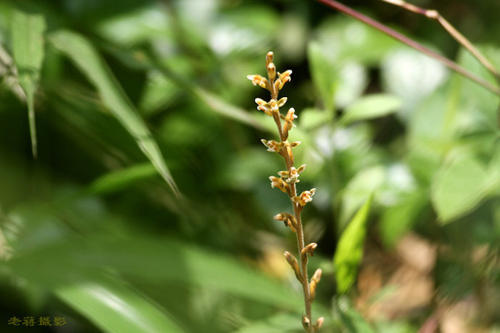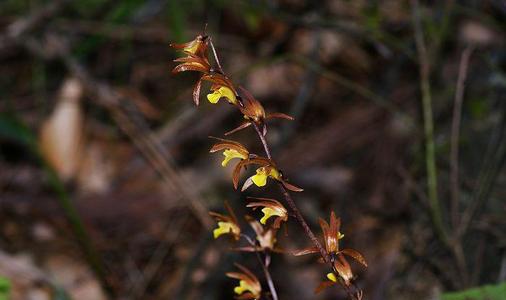Erythrodes blumei profile
Written by Maggie
Mar 22 2021

Erythrodes Blumei was developed by Schltr in 1905. Erythrodes Blumei is 18-60 cm tall. Rhizome is elongate, creeping, nodular, rooting at nodes. Stem is erect, terete, green, proximally with 3-6 leaves. Leaf blade is ovate, elliptic or ovate-lanceolate, sometimes slightly askew, dark green above, pale green abaxially, with 3 distinct main veins, stipitate; Racemes are terminal, with many dense flowers, 5 -- 10 cm long; Flowers are smaller, sepals reddish brown to brownish green, abaxially pubescent, middle sepals erect, concave, oblong, 4 -- 6 x 1.5 -- 2.5 mm, apex slightly obtuse; Lateral sepals are spreading, oblique elliptic or ovate-elliptic.
Erythrodes blumei is born in the shade of evergreen broad-leaved forests on hillsides or valleys at an altitude of 400-1500m.
Erythrodes blumei picture

Morphological characteristics of Erythrodes blumei
Rhizome
Erythrodes blumei plants are 18-60 cm tall. Rhizome is elongate, creeping, nodular, rooting at nodes. Stem is erect, terete, 2.5 -- 3.5 mm in diam., green, proximally with 3 -- 6 leaves.
Leaf
Leaves of Erythrodes blumei are ovate, elliptic or ovate-lanceolate, sometimes slightly askew, 4.5-10 cm long and 2-6 cm wide, acute at apex, wide cuneate or obtuse at base, dark green above and light green at back, with 3 obvious main veins and stripes; Petiole is 2.4-4 cm long, the lower part enlarged into an enveloping sheath. Flower stems are pubescent, 12-40 cm long, with 3-6 sheathlike bracts.
Inflorescence
Erythrodes blumei is terminal in raceme, with many dense flowers, 5 -- 10 cm long; Bracts are lanceolate, reddish-brown, 10 -- 12 x 4 mm, apex acuminate, abaxially pubescent; Ovaries are terete, reddish brown, torsion, pubescent, pedicels 9 -- 10 mm long; Flowers are smaller, sepals reddish brown to brownish green, abaxially pubescent, middle sepals erect, concave, oblong, 4 -- 6 x 1.5 -- 2.5 mm, apex slightly obtuse; Lateral sepals are spreading, obliquely elliptic or ovate-elliptic, 5.5 -- 6 mm long, 3 mm wide, apex acute or slightly obtuse.
Petals
Petals of Erythrodes blumei are oblanceolate, 4-6 mm long and 1.5-2 mm wide, obtuse at apex, the same color as sepals, with one transparent vein in the center, and fusing with middle sepals to form a sash. Lower sepal base spur, anteriorly 3-lobed, lateral lobes erect and small, middle lobes reflexed, broadly ovate or triangular-ovate, white, apex subacute; Spur is pendent, subcylindrica, 1.5-4 mm long, slightly enlarged at middle, terminal 2-lobed, glabrous and absent corpus callosum on inner surface, ventral (upper) and spur of labellum reddish brown; Stamen of Erythrodes Blumei is stout, erect, 1.5-3 mm long, without anterior appendage; Stamens beak is erect, forked 2-lobed.
Ecological habits of Erythrodes blumei
Erythrodes blumei generally grows on the mountainside and valley wall of deep mountains and valleys, sloping slopes or stone crevices with good water permeability and water retention, near sparse mountain grasses and under the shade of secondary miscellany forest. Or have shade, sunshine time is short or only the place where the star leaks light. Where the air is moist and can circulate, it is sometimes born on the side of mountain streams and cliffs. Erythrodes Blumei should be grown in a well-ventilated environment. Erythrodes Blumei likes shade, avoid direct sunlight, like wet, avoid dry, 15℃ to 30℃ most suitable for growth. Poor growth above 35℃. Cold temperature below 5℃ will affect its growth, when the orchid is often in a dormant state. If the temperature is too high and the sun is exposed to the sun, the leaves will burn or scorch within a day or two. If the temperature is too low and does not transfer into the house in time, there will be frostbite phenomenon. Erythrodes Blumei has fleshy roots, which are suitable for sandy loam rich in humus. The drainage performance must be good. Leaf-rot soil or mountain soil with more humus should be selected. Slightly acidic loose soil or soil containing iron, pH value of 5.5-6.5 is appropriate.
The propagation of Erythrodes blumei
In spring and autumn can be carried out Erythrodes Blumei division propagation, generally every three years a plant. Any plant with strong growth and dense pseudo corms can be divided, and at least 5 connected pseudo corms should be stored in each cluster after division. Before planting, reduce irrigation water, so that the basin soil is more than. After planting, cover the bottom hole of the pot with broken tiles, then lay coarse stones, which account for 1/5 to 1/4 of the depth of the pot, then put coarse-grained soil and a small amount of fine soil, and then plant with sandy loam rich in humus. Planting depth to the false corm just buried in the soil strength, basin edge to leave 2 cm along the mouth, spread grass or fine stones, finally pouring permeable, shady place for 10-15 days, keep the soil moist, gradually reduce watering, normal maintenance.

Disease & pest control of Erythrodes blumei
Sheath rust
Usually on the upper and lower surfaces of the leaves, rarely on the stem with raised vesicles containing yellow, orange, rusty, or even purplish black powdery spores. Rust is not fatal, nor does it kill the leaves, but it weakens the Erythrodes Blumei. Prevention methods in addition to cutting off the sick leaves, can be used 65% of the sun zinc powder 500-600 times the liquid or containing copper fungicides spray.
Southern blight
Mostly in the rainy season. At the beginning of the disease, the leaf base is full of white mycelium. Prevention and control method: remove fungus basin soil, sprinkle on pentachloronitrobenzene powder or lime. Radical cure method: pay attention to ventilation and light, basin soil drainage is good. Serious diseases Erythrodes Blumei are burned.
Anthrax
It occurs all the year round, and is more prevalent in hot and rainy seasons, especially in orchid. The spots first extend from the tip of the leaf to the rhizome of Erythrodes Blumei, brown at the beginning, and then gradually expand and increase, there are many dry black spots, which lead to the death of the whole plant in serious cases. Prevention and control methods: in addition to actively change the environmental conditions, in the onset period, can be used first with 50% methyl tobujin wettable powder 800-1500 times the liquid spray treatment, once every 7-10 days; Then supplemented with 1% equivalent Bordeaux liquid, once every half a month, continuous spray 3-5 times.
Scale insects
Commonly known as "lice''. They propagate fastest in conditions of high temperature, humidity and poor air flow. It can be sprayed with 1% diethoate oxide or 1500 times 50% mala sulfur during incubation period. If the number of pots is not much, it can also be brushed manually.
The distribution region of Erythrodes blumei
Erythrodes blumei is born in the shade of evergreen broad-leaved forests on hillsides or valleys at an altitude of 400-1500m.
Erythrodes Blumei is produced in Taiwan, Guangdong, Guangxi and Yunnan (Jinping). Sri Lanka, northeastern India, northern Myanmar, Vietnam, Thailand are also found.
The type specimens of Erythrodes blumei were collected from India (Casia).

Latest Updated
- Benefits of Bugleweed - 7 Science-backed Health Benefits
- Bugleweed Dangers & Side Effects - Is It Poisonous?
- How to Plant Evergreen Trees - What You Should Know
- When to Plant Evergreens - Grow Guide for Evergreen Trees
- 12 Wonderful Evergreen Shrubs for Your Garden
- 12 Popular Evergreen Plants with Pictures for Beginners
- When And How To Prune A Lilac Bush Like a Pro
- How to Grow & Care for Lilac Vine (Hardenbergia Violacea)
- Japanese Lilac Tree (Syringa Reticulata) Care & Propagation Guide
- Shumard Oak Pros and Cons - What to Know
Popular Articles
- Winter maintenance of Antirrhinum Majus
- How to Grow Terminalia Mantaly Tree
- How to Grow and Care for Crossostephium Chinense
- How to grow Antirrhinum Majus in spring
- Peristeria Elata (Dove Orchid) Profile: Info & Care Guide
- Underwatered Snake Plant (Sansevieria Trifasciata) - Signs And How To Fix
- How to Care for Brazilian Jasmine Plant (Mandevilla Sanderi)
- How to Grow & Care for Graptopetalum Purple Delight in Summer
- Rosa Chinensis (China Rose): Plant Growing & Care Tips
- How to Care for Baby Sun Rose (Aptenia Cordifolia)